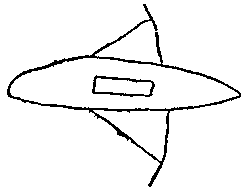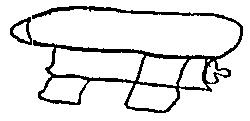THE YEAR 1909 was a tense time for New Zealanders. For centuries, Britain had the world’s unrivalled navy, and an invasion of the motherland was unthinkable. Her colonies and outposts enjoyed similar protection. But all of that changed in 1908, and with an unnerving suddenness, as grave concerns were expressed in Great Britain over Germany’s rising military strength which prompted fears a surprise invasion might be launched at any time.
Why the sudden concern? In the wake of rapid aeronautical advancements coupled with Germany’s Zeppelin development, the British Empire appeared vulnerable to attack by the air. According to historian Alfred Gollin in his book No Longer an Island: Britain and the Wright Brothers, 1902-1909 (1984, London: Heinemann), “It was realized…that as soon as an efficient flying machine made its appearance, England lay open to an invasion from the air, that her traditional reliance upon the Navy and seapower was no longer so valid…(p. 2)”
Early in 1909, two subjects dominated New Zealand newspapers: rapid aviation advancement and concern over the adequacy of the country’s defence from a potential German invasion. Then by mid-year, dominion press discussion changed its focus away from the likelihood of Germany directly attacking the British Isles, to concern that they might instead attack the Empire’s more vulnerable, remote outposts. This fostered great anxiety in distant New Zealand. Shortly thereafter, invasion fears intensified as the British announced a new policy to concentrate its naval fleet near the motherland.
It was amid this anxiety that during July and August of 1909, a remarkable social delusion swept across the entire country. Tens of thousands of citizens were not only convinced that a hostile German Zeppelin or Zeppelins were spying and possibly ready to drop bombs under the cover of darkness, but many were certain that they had actually seen the vessel. While this may seem like an inflated figure (tens of thousands), in many instances the population of entire towns were reported to have filled the streets to glimpse mysterious aerial lights, typically assumed to have been of German origin.
The Sightings
The episode began on the evening of July 11th in the South Island, when according to the Otago Daily Times, several Kaitangata residents reported observing the mysterious light of a possible airship for 30 minutes as it bobbed in and out of view to the east over the Wangaloa Hills. The witnesses were prepared to sign an affidavit as to their veracity. The Evening Star reported the that the German vessel Seestern, which had recently left Australia bound for New Zealand, had launched the Zeppelin from its deck to spy on the countryside and then return to the ship.
By the last week in July, a massive outbreak of sightings occurred from one end of the country to the other. There were so many that I will highlight some of the more colourful ones. Perhaps the most spectacular incident took place on Friday July 23rd in broad daylight at Kelso, where 23 schoolchildren and an adult described a Zeppelin-type airship swooping low over the township, of which several detailed sketches were produced by witnesses. An excited reporter for the Otago Daily Times proclaimed it to be “nothing short of dumbfounding.” The sketches appear as follows: The 3 drawings below all appeared in the Otago Daily Times, August 4, 1909.
 |
 |
 |
At about 5 pm on the next day (July 24th), another student at the Kelso school, George McDuff saw the above vessel near his home. Sixty years after the incident, a reporter for the Otago Daily Times tracked down McDuff. He was a farmer living at Weston in North Otago. When asked about the incident, he denied seeing any object and said that it was “imagination, based on what we were reading at the time” (magazine articles describing airships).
The editors of the Wanganui Chronicle were less impressed by these drawings and challenged the Otago Daily Times reporter in declaring that “there is nothing convincing to report” about the mass sightings near the Kelso school, and that “the testimony of the children need not be taken very seriously.” It was later suggested that they had misidentified a flock of birds.
Shortly after this sighting, a party of young men from Kelso trekked into the nearby Blue Mountains in a vain attempt to locate the vessel, and local police were also searching. This incident received heavy press coverage, and a deluge of reports followed over the next 10 days.
On the evening of July 24th just a few miles away at Kaka Point, another dramatic account was recorded of an airship flying over the beach. A Mr Bates and several boys observed “a huge illuminated object moving about in the air.” The Clutha Leader stated that the vessel appeared as if it was going to alight, and in apparent fear that it was a German Zeppelin, thinking it was attracted to their lantern, the boys ran off leaving it behind. If the vessel flew within close range again, some of the boys said they would “try to prick the bubble’ with a bullet.”
Near Gore on July 30th, the Auckland Star reported that two mining dredge hands working the night shift claimed to see an airship at 5 am descend in the fog and circle the area, and “that two figures were plainly discernible on board”. The time and location of this sighting suggests that they misidentified the moon. Later that day, the Evening Star said that great interest was generated by a rumour that a Zeppelin had crashed at Waikaka, killing two or three Germans. The report by the dredge hands followed other airship sightings in the Gore vicinity over the previous several nights.
The Geraldine Guardian reported that on Sunday evening August 1st, a large crowd gathered in front of the Temuka post office, debating the origin of a mysterious luminous orb which was soon revealed as a prank by some boys who had placed a candle in a hollowed turnip and raised it to the top of the High School flagpole.
According to the Hawkes Bay Herald, on Tuesday night, August 3rd, in the North Island, a Waipawa man stated that while riding his horse near the racecourse, a large, grey torpedo-shaped vessel with lights at the prow and stern, passed overhead, and one of three visible passengers “shouted out to him in an unknown tongue.”
By early August the New Zealand reports began to wane, with the last known sighting of the month reported by the Geraldine Guardian near the goldmining community of Waihi on the 9th.
Once the Zeppelin’s existence was widely accepted, various past and concurrent events and situations that would have ordinarily received prosaic interpretations, were redefined as airship-related. On the night of July 14th, Mary Guinan of Kelso observed a gradually dimming “star”, but after hearing of subsequent airship sightings, the Otago Witness reported that “she at once concluded that it was this she had seen”.
When a farmer in the Black Hills found two petrol cans on a remote eminence inaccessible by motor car, according to the Timaru Post, it was suggested the oil was used to fuel an airship motor. In the Otama district, another farmer thought an airship may have landed for repairs after finding several screw wrenches in a field.
Many press accounts described the airship’s presence factually, especially at the beginning of the episode, when ambiguous aerial “lights” were often depicted as “airships.” These include stories in the following newspapers: “Clear evidence,” Evening Star, July 29, 1909, p. 4; “The Kelso airship. Cumulative evidence,” Otago Daily Times, July 29, 1909, p. 7; “What the dredge-men saw,” Auckland Weekly News, August 5, 1909, p. 21. However, as the episode continued, the press generally grew more incredulous of the reports.
Aerialitis
The Wellington Dominion characterised some witnesses as suffering from “aerialitis”. It was widely noted in many newspapers from late July that sales of fire balloons had increased dramatically, and their remains were often found in the vicinity of sightings.
Press accounts became increasingly sceptical in early August, as numerous reports of mysterious aerial lights were increasingly described as stars, illuminated kites or fire balloons. These latter devices consisted of paper balloons with candles attached near the mouth and made buoyant by the generation of heat.
On July 29th, the New Zealand Herald editor described them as “Flights of Fancy”, while commentary in the Evening Post referred to them as “Hot-air” ships, remarking that a combination of hoaxes and misperceptions of heavenly bodies comprised “the nucleus of an aerial German invasion”.
After residents reported seeing what appeared to be a searchlight circling above the town of Nelson, a reporter Thames Star quipped: “It has come at last. We have been expecting the dread news for weeks…” Advertisers even capitalised on the airship excitement with one proclaiming in the Tapanui Courier: “The latest news by air ship sent to Kelso was that Anderson’s selling out sale is still booming…”
After a three-week absence of reports, a final flurry of sightings emanated from Gore, as hundreds reported a dark cigar-shaped object near the Tapanui Hills between 4:30 and 6 pm on September 1st and 2nd. The reports in the Southland Times abruptly ended when a press correspondent visited the site and found that the sensation was caused by “repeated flights of thousands of starlings, which, prior to nesting season, were making their temporary homes in a clump of pine trees” at Holland’s farm. With the Gore sightings, this unusual chapter in New Zealand history had come to a close.
Some Final Comments
The Zeppelin sightings can be explained using basic theories of social psychology. Human perception is highly unreliable, subject to error, and pre-conditioned by the observer’s frame of reference or “mental set.” In ambiguous situations such as looking for an ambiguous object in the night-time sky, “inference can perform the work of perception by filling in missing information in instances where perception is either inefficient or inadequate”.
The Zeppelin scare is a classic example of a collective delusion or “mass hysteria.” Most sociologists nowadays prefer the former term as most participants in episodes are certainly not hysterical in the clinical sense. The literature on collective delusions indicates the pivotal role of several key factors. These include the presence of ambiguity, anxiety, the spread of rumours and false but plausible beliefs, and a redefinition of the potential threat from general and distant to specific and imminent.
Exacerbating factors include the fallibility of human perception, mass media influence in spreading the fears, recent geo-political events, and reinforcement of the false belief by authority figures and those in institutions of social control (for example, the police and military or a university lecturer).
There was great ambiguity in that despite intense press speculation, no one knew how real the German threat to New Zealand was, or if the rumours were true and Zeppelins were navigating in the skies. It was not known whether they possessed the motivation, means and resources to launch aerial missions. Recent advances in aviation technology lent plausibility to the rumours. The ambiguous night-time sky was ideal for fostering misperceptions of stars, planets and other natural phenomena. When an observer scrutinises an object such as a star, it can appear to change colour, flicker and move.
Of particular interest is what social psychologists call “the autokinetic effect”. This illusion was first identified by social psychologist Muzafer Sherif in 1936, who found that in a dark environment, when people stare at a single point of light, the light appears to move — often dramatically — even though in reality it is stationary. The difficulties in judging distance and movement under such conditions occur because objects such as buildings, cars and people usually provide a familiar frame of reference with which to base judgements. However, in dark settings these cues are either greatly diminished or not available. This situation is similar to New Zealanders staring at the sky in search of Zeppelins at night.
By comparing the New Zealand Zeppelin sightings with modern flying saucer reports worldwide since 1947, we can gain important insights. History can be a powerful tool for skeptics, as it distances observers from events and allows for a less emotional, more contextual evaluation of seemingly incredible events. Perhaps the most conspicuous difference between the two periods is the absence of a single reported disc-shaped object during the 1909 episode.
The mechanisms that gave rise to the Zeppelin scare of 1909, and modern flying saucer reports, appear to be virtually identical. The only significant difference is the social and cultural expectation or frame of reference of the witnesses.
In 1909, citizens did not expect to see flying saucers, but dirigible or boat-like airships with wings and or propellers. And that is exactly what they reported. Today, no one reports seeing phantom Zeppelins in New Zealand (at least, to my knowledge!), but aliens in flying saucers.
References available from the editor.
